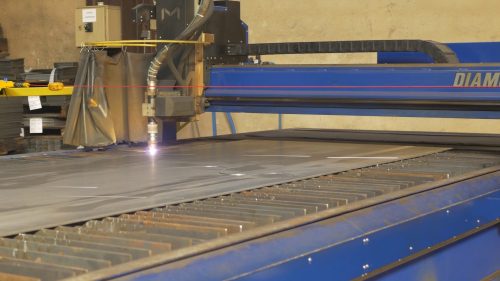Custom fabricators use a range of tools to produce perfectly processed metal sheet, plate, and other parts. Two of the most popular tools are waterjet cutting machines and plasma cutting tables. How do these two machines compare in how they fabricate materials? Before we take a closer look, let’s review how they function.
How Waterjet Cutters & Plasma Cutters Work
In waterjet cutting, highly pressurized water is mixed with an abrasive material, such as garnet, and forced at high velocity through a miniscule nozzle. The resulting stream is powerful enough to cut through metal. Plasma cutting tables create an electrical connection between the plasma and the material, generating a powerful flame that cuts through plate. Because an electrical connection is necessary, plasma cutting machines can only process conductive metals.
Key Differences
Now that you have a general understanding of how each machine works, let’s review how they deliver on these key factors:
Cut Quality
Waterjet cutting is more accurate than plasma cutting and can hold tolerances of +/- .005 inches (plasma cutting’s accuracy ranges from +/- .01–.03 inches). Additionally, because waterjet cutting does not introduce heat into the fabrication process, it can handle thicker plate than a plasma cutting table—the plasma torch will start generating unwanted slag when thickness gets to be more than ½ inch.
Maintenance
Because the water in a waterjet cutting machine is under immense pressure, parts begin to wear down more quickly than a plasma cutter. Both replacement parts and the process of keeping the water tank clean can come with a hefty price tag. Plasma cutting, on the other hand, requires less regular maintenance as it only has one consumable (the plasma) and fewer parts that can break down. That being said, even plasma cutters need to be properly maintained to ensure smooth performance.
Materials
As noted above, because a plasma torch requires an electrical connection, it can only process conductive materials like steel. Waterjet cutting offers more flexibility in the type of material it can fabricate. Steel, aluminum, titanium, brass, and exotic metals are all fair game.
Cost
Both fabricating tools offer an affordable solution for custom metal fabrication. Operating costs are lower when plasma cutting machines are used for fabricating thinner plate. If a thicker material needs to be processed, a waterjet cutting table is ideal and will help reduce waste. However, as mentioned, waterjet cutters require more upkeep, which can cause costs to rise.
Industry-Leading Waterjet Cutting & Plasma Cutting Tables
Machitech is the leading innovator of heavy-duty waterjet cutting machines and plasma cutting tables for custom fabrication. Our solutions feature automated technology and include free and unlimited support for life. To learn more, contact the experts at Machitech today.
 English
English  Français
Français 
